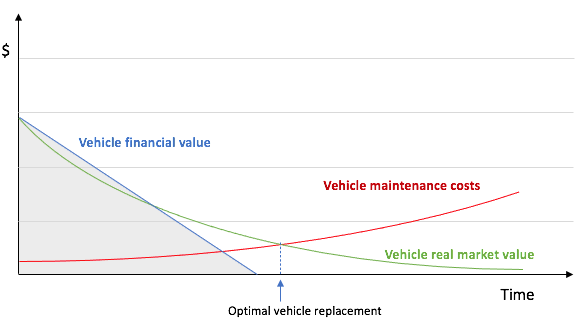Managing the entire vehicle life-cycle of vehicles is essential to achieve an efficient use of resources, including the eventual decommissioning or disposal of vehicles. It is preferable to sell and/or replace vehicles before they become too expensive to maintain, and so ensure that their optimal resale or replacement value can be achieved.
Benefits of properly decommissioning, disposing and replacing vehicles, include:
- Contributing to lower maintenance costs.
- Lower CO2
- Optimising the selling price of the vehicle.
Economic Life
“Economic life” is the expected period of time during which an asset remains useful to the average owner. When an asset is no longer useful to its owner, it is considered past its economic life. The economic life of the vehicle should be defined by each agency as part of its asset management policy: some may consider 48 months, some other consider 60 months.
The example below shows a linear estimation over time of the value of a vehicle procured valued at USD $20,000, considering 48 months of economic life.
More complex models can be applied to represent the vehicle value over time. As an example, a curved exponential approach may be more accurate for certain purposes, as the vehicle loses much of its value after its first usage. Economic life can be calculated by determining the point at which the estimated resale value of a vehicle becomes lower than the annual operating costs.

Due to the nature and cost of many vehicles owned and operated by humanitarian agencies, many organisations may choose to sell a vehicle well before the maintenance cost reach the same level as the repair costs. This holds especially true for operations in which the risk of an inopportune break down is more than just the cost of repair. This might include:
- The real safety of the vehicle may diminish if agencies operate in insecure environments that require emergency vehicles at all times.
- Rugged or off-road terrain that requires consistent performance from vehicles.
Below is an example of the changing resale costs vs maintenance costs compared to the original purchase value:
| Year | Original Purchase Cost | Estimated Resale Value | Annual Cost of Maintenance and Fuel |
|---|---|---|---|
| 1 | $50,000.00 | $45,000.00 | $5,000.00 |
| 2 | $50,000.00 | $40,000.00 | $5,500.00 |
| 3 | $50,000.00 | $38,000.00 | $6,000.00 |
| 4 | $50,000.00 | $35,000.00 | $6,500.00 |
| 5 | $50,000.00 | $32,000.00 | $7,000.00 |
| 6 | $50,000.00 | $29,000.00 | $7,500.00 |
| 7 | $50,000.00 | $25,000.00 | $8,000.00 |
| 8 | $50,000.00 | $22,000.00 | $8,500.00 |
| 9 | $50,000.00 | $19,000.00 | $9,000.00 |
| 10 | $50,000.00 | $16,000.00 | $9,500.00 |
Agencies should always keep in mind that the economic life of an asset is different than its actual physical life. Vehicles will usually always live longer than their respective economic lives to an agency, and the relationship between the two will depend on the utilisation of the vehicle and the operational conditions. In this sense, it is common to set a limit in mileage to start considering replacing a vehicle - 200,000 Km (+/- 50 000 Km) is often used as a basic rule.
Some agencies may decide to extend the life of a vehicle beyond its economic life. This is especially pertinent when a good maintenance scheme has been applied and records show that the costs of maintaining the vehicle is still below its market resale value. The decision of replacing a vehicle should be sustained by consistent fleet management records reflecting costs, utilisation, safety, and asset age.
Furthermore, depending on the country legislation related to the humanitarian agencies and the funding mechanisms used to purchase the vehicle, some limitations to this logic may be applicable. Come countries don’t allow private NGOs to resell assets like vehicles and some donors require the donation or transfer of vehicles at the end of the project to another funded agency or project. Being aware of country legislation and donor’s specific procedures related to assets and vehicle management is of key importance to avoid incurring significant legal or financial risks.
Decommission and Disposal
Once the decision for vehicle replacement is taken, different options for old vehicle decommissioning and disposal should be considered. The most common disposal methods are:
- Donation - vehicles in good condition and meeting safety requirements may be subject to donation to partner agencies or key stakeholders. Donations must follow national legislation and internal policies and need to be properly documented.
- Sale - vehicles that are not needed and have a viable market value may be subject to resale. To avoid any suspicions on favouring particular entities or people, a fully documented auction is recommended. Resale of a vehicle must follow national legislation and internal policies and need to be properly documented.
- Transfer - vehicles in good condition and meeting safety requirements may be subject to transfer to another entity or programme. This is the preferred option by most donors when the vehicle remains within its economic life. Also, it is a convenient solution when closing projects or dismantling local offices with vehicles assigned.
- Destroy or harvest for spare parts - vehicles in poor condition or not meeting safety requirements should be destroyed or dismantled to recover usable parts. A public or private institution with capacity to properly perform the task should be identified. Environmental risks assessment needs to be performed and a certificate of destruction may be required by the authorities to update the vehicle registry and to formalise the vehicle withdrawn from circulation. Notifying authorities may be especially important to avoid further tax charges or liabilities.
As part of the decommissioning process, agencies should remember to recover and reassign all the vehicle equipment that could be reused, including communications equipment, safety material, recovery kits, identification/visibility, and more. Agencies should also remember to inform authorities and insurance companies once vehicles are no longer in use.


